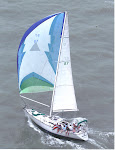The
Washington Channel is a remarkable body of water at the head of
sailboat navigation on the Potomac River. It lies along the
waterfront of SW Washington DC. It is well marked and easy to
access. The anchorage is about two miles long, 1/3 mile wide and
about 15 deep. Fort McNair with the National War College guards the
western entrance.
The East Potomac Park comprised the eastern shore
of the anchorage. An amazing open air fish market, Captain White's
lies to the north while I-395 thunders overhead. The Tidal Pool is
continuous with the Washington Channel but is closed to traffic. The
Washington Monument is clearly visible to the north. Most importantly
it lies only 10 long blocks from the Washington Mall. Buses and
Metro access is available for those who do not walk.
National War College
Few
cruisers seem to come this way. It is at the end of a 110 n. mile
run up the Potomac River. Most of the trip is by motor as breeze is
a problem on the Potomac. White Pepper
was the only boat to arrive in the week we were there. To be fair we
were there in July when it is blisteringly hot.
Massive
changes are about along the Washington Channel. The Wharf
Corporation plans to remake the entire waterfront. No less than 6
cranes are busy all day erecting huge buildings.
The Capitol Yacht
Club and Gangplank Yacht Club will be consumed in the building. The
docks are being completely reworked. Anchoring will be banned in the
channel and 8 new mooring balls have been installed just this month,
July 2016. Holding in the channel has been reported as poor.
Thus White Pepper
was pleased to be on one of these new mooring balls when on our
second night a powerful thunder storm blew through. The wind was
swirling about 40 knots and hail as large as golf balls rained down.
Locals said it was the worst thunder storm in a long time.
Massive Construction
White Pepper on a mooring ball. Washington Monument in background.
We
visited family, who live in the area. We renewed acquaintance with
old cruising friends, JR and Drena from Journey,
who have temporarily swallowed the hook and live nearby.
However,
the principal charm of this anchorage is its close proximity to the
Washington Mall. The mall is in my opinion the best tourist
attraction in this country and it is all completely free. One day we
did all of the main monuments—Jefferson, FDR, MLK, Korean War,
Lincoln, WWI, WWII, John Paul Jones and waved at the Washington
Monument. Another entire day was spent at the Aerospace Museum. The
next day we spent avoiding the ferocious heat viewing the National
Gallery of Art. Jan and I could only see one quarter of one of the
two buildings in one entire day. We spent the last day with the kids
at the International Spy Museum which is a commercial, but very fun,
experience.
I
do have one snarky comment about the Aerospace Museum—that is that
the artifacts of the old space race, such as the Gemini capsule, are
starting to show signs of age. Then I realize that all of this was
over 45-50 years ago. Very upsetting. Remarkably the paintings in the
National Galley some of which are over 800 years old look quite fresh
and new. I wonder if they have not been restored somewhere along the
line. It was amazing to see some of the most famous paintings in
history right there in our national gallery.
Finally
after a week White Pepper
was driven off the mooring ball by the relentless heat. Hopefully,
it will be cooler on the Chesapeake Bay. However, Jan pointed out on
our last day, that one week on our mooring ball was cheaper than one
night at any Washington DC hotel. And since we took most of our meals
on the boat, the cost of our Washington DC visit was almost
negligible.


















